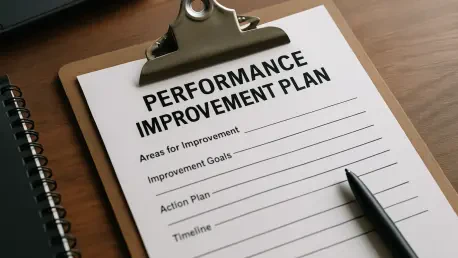Imagine walking into a sterile boardroom, expecting a routine check-in, only to be handed a Performance Improvement Plan (PIP) that feels like a professional death knell, signaling for many employees the beginning of the end. For countless individuals, this document serves as a formal warning that their job hangs in the balance. The initial wave of fear and embarrassment can be paralyzing, especially in a corporate culture where such plans are often stigmatized as a precursor to termination. Yet, what if this daunting moment could be reframed as a catalyst for profound growth? Stories from professionals who have navigated this path reveal that a PIP, while intimidating, can become a turning point, offering lessons in resilience, communication, and self-worth that outlast any single job.
Understanding the PIP Experience
Initial Fear and Stigma
The moment a PIP lands on an employee’s desk, it often triggers a visceral reaction of dread and humiliation. This formal critique of performance is frequently perceived as a corporate scarlet letter, marking someone as a failure in the eyes of colleagues and superiors. The emotional toll is heavy—stress levels spike, self-doubt creeps in, and the fear of impending job loss looms large. In many workplaces, the stigma surrounding PIPs amplifies this anxiety, as they are rarely discussed openly, leaving employees to grapple with shame in isolation. This perception can erode confidence, making it challenging to see the plan as anything other than a punitive measure designed to push someone out the door rather than support improvement.
Beyond the personal impact, the cultural lens through which PIPs are viewed adds another layer of complexity. In corporate America, these plans are often shrouded in secrecy, with little transparency about their purpose or potential for positive outcomes. Employees may feel singled out or unfairly judged, especially if the criteria for being placed on a PIP seem arbitrary or poorly communicated. This lack of clarity fuels a narrative of defeat, overshadowing any constructive intent behind the process. Addressing this stigma requires a shift in perspective, recognizing that while the initial shock is real, it doesn’t have to define the journey ahead. The emotional hurdle is significant, but it can be the first step toward reclaiming control over one’s professional narrative.
Role of Workplace Environment
The environment in which a PIP arises often plays a critical role in shaping the challenges that lead to it. Take, for instance, the chaotic nature of many startup settings, where constant pivots in strategy, frequent changes in leadership, and shifting priorities can leave employees struggling to find solid ground. Such instability makes it difficult to meet expectations when roles and goals seem to change overnight. Deadlines become moving targets, and without clear guidance, even the most dedicated individuals can falter. This lack of structure isn’t just a personal failing—it’s a systemic issue that can exacerbate burnout and hinder performance across teams.
Equally important is the shared responsibility between employee and employer in navigating these turbulent waters. While individuals must manage their workload and seek support when needed, organizations bear the burden of providing clear direction and reasonable expectations. When workloads are unassessed or support systems are lacking, employees are set up for struggle, regardless of their effort. A PIP in such a context can feel like a harsh judgment on personal shortcomings, when in reality, it often reflects broader organizational dysfunction. Recognizing this dynamic is crucial, as it shifts some of the weight off the individual and highlights the need for better communication and resource allocation within the workplace.
Turning Crisis into Opportunity
Shifting Mindset to Proactive Action
Transforming a PIP from a threat into an opportunity begins with a fundamental change in mindset. Rather than viewing it as a signal of inevitable failure, it can be approached as a form of constructive feedback—an invitation to identify gaps and address them head-on. This shift isn’t easy, especially when emotions run high, but it empowers employees to take ownership of their growth. Stories of professionals who have walked this path often highlight a pivotal moment of decision: to wallow in defeat or to act. Choosing action means reframing the PIP as a roadmap, one that, while imposed, can still be navigated with intention and purpose to rebuild trust and demonstrate capability.
Practical steps are essential in translating this mindset into tangible progress. Tools like Asana or similar project management platforms can help organize tasks and deadlines, bringing much-needed structure to chaotic workloads. Regularly updating managers with status reports ensures that efforts are visible, countering any perception of disengagement. Seeking clarity on ambiguous instructions also proves vital, as it prevents missteps and shows initiative. These actions, though seemingly small, accumulate into a powerful demonstration of commitment. They shift the narrative from one of struggle to one of proactive improvement, proving that even under scrutiny, growth is possible with deliberate effort.
Power of Self-Advocacy
One of the most transformative lessons from facing a PIP is the importance of self-advocacy, even when it feels uncomfortable. For many, especially younger professionals or those in marginalized groups, speaking up can seem risky, carrying the fear of appearing confrontational or incompetent. Yet, asking questions about unclear tasks or pushing for alignment on conflicting priorities is not just necessary—it’s a critical skill. This act of asserting one’s needs helps clarify expectations and prevents unnecessary missteps. More importantly, it signals to managers a willingness to engage and improve, turning potential criticism into a dialogue of collaboration and understanding.
Beyond clarifying tasks, self-advocacy also involves ensuring that contributions are recognized. Often, hard work goes unnoticed if it isn’t communicated effectively, leading to what some call a “publicity problem” in the workplace. By proactively sharing updates and highlighting achievements, employees can reshape how their efforts are perceived. This isn’t about seeking praise but about owning one’s narrative and ensuring fairness in evaluation. The confidence gained from such actions often extends beyond the immediate situation, equipping individuals with a lifelong ability to stand up for themselves in any professional setting, regardless of the challenges they face.
Building Resilience Amid Setbacks
Growth Beyond the Outcome
Even when a PIP is navigated with diligence and improvement, external factors like company-wide layoffs can still disrupt the journey, leaving employees jobless through no fault of their own. Such outcomes sting, especially after pouring effort into turning things around. However, the true measure of success lies not in retaining the role but in the personal growth achieved along the way. Sharper communication skills, refined time management, and a newfound sense of confidence often emerge as lasting takeaways. These intangible gains become the real victory, equipping individuals to tackle future challenges with a stronger foundation, regardless of immediate results.
Reflecting on such experiences, it becomes clear that internal growth often outshines external setbacks. The resilience built through addressing a PIP head-on fosters a mindset of adaptability, where obstacles are seen as opportunities to learn rather than insurmountable barriers. This perspective shift is invaluable, as it reframes professional adversity as a chapter in a larger story of development. Employees who embrace this often find themselves better prepared for uncertainty, carrying forward a belief in their ability to evolve. The skills and self-assurance gained during tough times prove to be assets that no layoff or restructuring can erase.
Lessons for Future Challenges
Looking back on the journey of overcoming a PIP, the experience revealed enduring strategies for navigating workplace adversity. Staying organized with digital tools and maintaining visibility through consistent updates proved essential in demonstrating effort and accountability. Equally critical was the habit of asking probing questions to clarify expectations, a practice that prevented misunderstandings and built trust with supervisors. These habits, honed under pressure, became second nature, offering a blueprint for handling future professional hurdles with clarity and purpose.
As a final reflection, the path through a PIP underscored the importance of preparing for all outcomes, including the unexpected. Keeping a résumé updated and networking actively ensured readiness for sudden changes like layoffs. More than anything, the focus shifted to proving resilience not to others but to oneself, recognizing that personal strength is the ultimate takeaway. For anyone facing similar challenges, the advice remains clear: embrace proactive steps, advocate for clarity, and view setbacks as stepping stones. These lessons, forged in difficult moments, paved the way for lasting confidence and capability in any career landscape.









